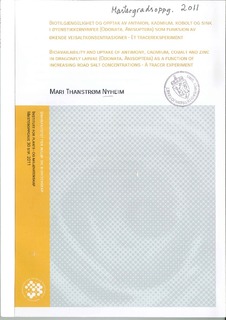Biotilgjengelighet og opptak av antimon, kadmium, kobolt og sink i øyenstikkernymfer (Odonata, Anisoptera) som funksjon av økende veisaltkonsentrasjoner - et tracereksperiment
Master thesis
Permanent lenke
http://hdl.handle.net/11250/189348Utgivelsesdato
2011-12-05Metadata
Vis full innførselSamlinger
- Master's theses (IPM) [204]
Sammendrag
Lang vintersesong fører til at det brukes store mengder veisalt (NaCl) på norske veier. Store deler av veisaltet som spres på veiene ender opp i veinære vannforekomster og rensedammer. Høye saltkonsentrasjoner i vannfasen kan øke mobiliseringen av tungmetaller fra sedimentet og påvirke biota som lever i vannforekomstene. Denne oppgaven undersøker hvordan veisalt i vannfasen påvirker mobiliteten til Co, Cd, Sb og Zn i sediment og hvordan dette påvirker akkumulering av disse metallene i nymfer av Øyenstikkere (Odonata). Dette er undersøkt ved hjelp av tracerteknikk i et laboratorieeksperiment ved bruk av henholdsvis Co-60, Cd-109, Sb-125 og Zn-65. Nymfer av underorden Libeller (Anisoptera) ble eksponert for moderat kontaminert sediment og vann med ulike saltkonsentrasjoner (0, 500, 5000 og 10 000 mg NaCl/L).
Det ble benyttet sekvensiell ekstraksjon på sedimentet for å undersøke bindingen og mobiliteten til metallene. For Co-60 og Cd-109 ble det funnet positiv korrelasjon mellom saltkonsentrasjon og aktivitet i vannfasen, og positiv korrelasjon mellom saltkonsentrasjon og de fraksjonene som antas som biotilgjengelige ved sekvensiell ekstraksjon. Sb-125 så ut til å være hardt bundet til sedimentet og ble lite mobilisert av veisalt i vannfasen. Grunnet lav aktivitet av Zn-65 i sedimentet var det vanskelig å trekke konklusjoner for dette metallet.
Nymfene akkumulerte Cd-109, Co-60 og Sb-125. Zn-65 ble ikke akkumulert. Basert på verdier for bioakkumulasjonsfaktoren (BAF) var rangeringen for akkumulering av de ulike metallene i følgende rekkefølge: Co-60 > Cd-109 ≈ Sb-125 > Zn-65.
For Co-60 og Cd-109 førte økt saltkonsentrasjon i vannfasen ikke til økt opptak av metallene i nymfene, det så heller ut til å være en motsatt trend. For Sb-125 var derimot metallopptaket lavest i kontrollgruppa som ikke ble tilsatt veisalt. For Zn-65 var både aktiviteten i vannfasen og nymfene så lav at det er vanskelig å trekke noen konklusjoner utfra resultatene. Autoradiografi og målinger av nymfer som skiftet exoskjelett viste at akkumuleringen av Co-60 eller Cd-109, eller begge metallene, fordelte seg i indre organer og vev samt exoskjelettet. Because of the long winters in Norway, the amount of road salt needed to keep the
roads ice-free is high. A large part of this road salt ends up in ponds close to the
roads. High concentration of salt may increase the mobilization of heavy metals in
sediments and effect biota living in the ponds. This thesis investigates how road salt
in the aqueous phase affects the mobility of Co, Cd, Sb and Zn in sediment and how
this affects the accumulation of these metals in nymphs of Odonata. This was done
using 60Co, 109Cd, 125Sb and 65Zn and tracer technique in a laboratory experiment.
Nymphs of dragonflies (Anisoptera) was exposed to moderate contaminated sediment
and water with different salt concentrations (0, 500, 5000 og 10 000 mg NaCl/L).
Sequential extraction was used on the sediments to investigate the mobility and
bindings of the metals. For 60Co og 109Cd a positive correlation was identified
between the salt concentration and activity in the aqueous phase, and between the salt
concentration and the fractions that is asumed to be bioavailable in sequential
extraction. 125Sb seemed to be tightly bound to the sediment and were not mobilized
by road salt in the aqueous phase. Due to low activity of 65Zn in the sediment it was
hard to draw any conclusions for this metal.
The nymphs accumulated 109Cd, 60Co and 125Sb, while 65Zn showed none
accumulation. Based on values of the bioaccumulation factor (BAF), the ranking of
the accumulation of the different metals appeared to be as follows: 60Co > 109Cd ≈
125Sb > 65Zn.
An increase in salt concentration in the aqueous phase did not lead to an increase in
the accumulation of 60Co og 109Cd in the nymphs, rather the opposite trend was
obsverved for these metals. This was not true for 125Sb which had the lowest
accumulation in the control group with no added road salt. For 65Zn the activity in the
aqueous phase and in the nymphs was so low that it was hard to draw any conclusions from the results.
